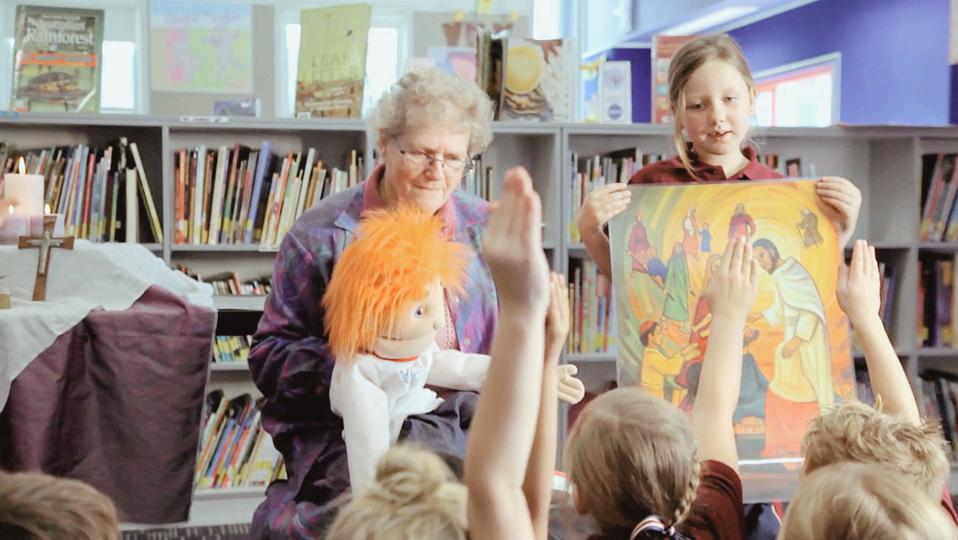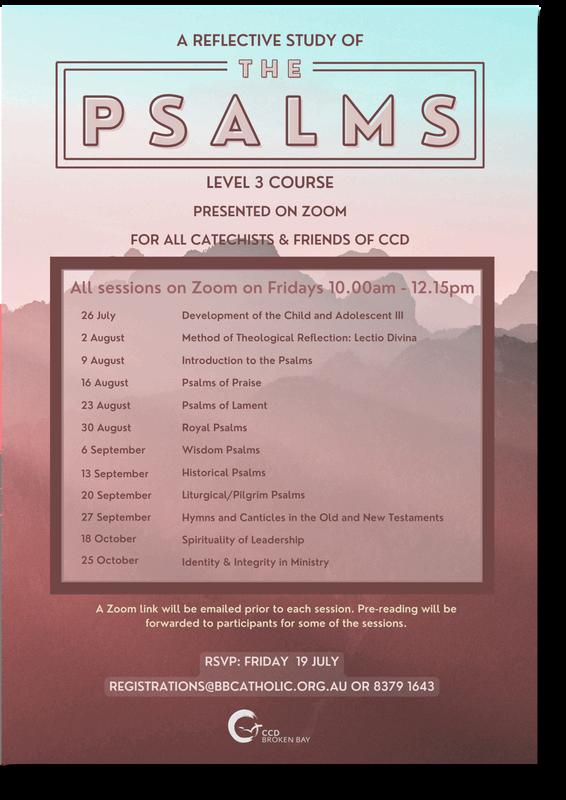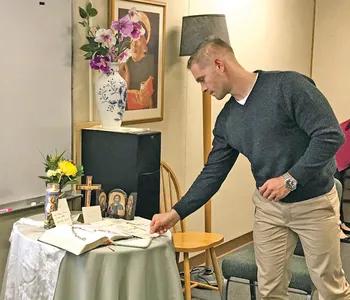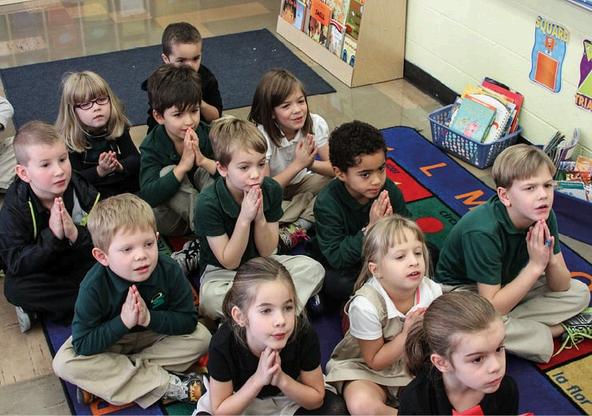




VOL28 ISSUE 3 2024 TERM 3 EVANGELISE + GATHER >< SEND > 4-5 REGIONAL COORDINATORS 6-7 SPIRITUALITY 8-9 COPY’N’KEEP 14 PRAYER IDEAS Called to Pray Called to Pray POPEFRANCIS’ YEAROFPRAYER
CONFRATERNITYOF CHRISTIANDOCTRINE BROKENBAY
ALISON NEWELL
Head of CCD Broken Bay
P:83791637
E:alisonnewell@bbcatholicorgau
MARICEL MALAPIRA
Diocesan CCD Admin
P:83791638
E:maricelmalapira@bbcatholicorgau
KRISTY KOMADINA
North Shore Region
P:83791674


IE:kristykomadina@bbcatholicorgau
SUE-ANNE SHERWOOD
North Shore Region
P:83791639
E:sueannesherwood@bbcatholicorgau
JOHN DONNELLY
Northern Beaches Region
P:83791640
E:johndonnelly@bbcatholicorgau
MICHAEL TEBBUTT
Central Coast Region
P:83791641
E:michaeltebbutt@bbcatholicorgau
ALICIA KLEIN
Diocesan CCD Admin
P:83791642
E:aliciaklein@bbcatholicorgau
Registrations for CCD Training
P:83791643
E:registrations@bbcatholicorgau
WWJ Curriculum Resources
P:83791642
E:ccdresources@bbcatholicorgau



trust as this edition of Connections reaches you, that you have enjoyed a wellearned mid-year break It’s hard to believe we are halfway through the school year already By now, of course, you will have established a great working relationship
with your students, and I hope you are experiencing some special moments in the classroom as you and the students explore their relationship with Jesus, the Church, and the world around them This wonderful faith sharing experience is one of the joys of teaching religious education to children and young people We journey together in faith in the SRE classroom and learn from each other The joy of teaching SRE is sometimes contrasted by the challenges of dealing with behavioural issues, inadequate accommodation, competing activities and other concerns that seem to come along from time to time One of things I admire most about SRE catechists is that you just “get on with it” and despite the challenges which you might face, you are inspired to bounce back each week as you go about your ministry The Holy Spirit is alive and well in SRE

Our public schools are an important part of the life of our parishes Special Religious Education is a subject like no other subject in public schools. Each time we go into that space we bring the face of Christ to the children and young people It is vital that we embody what we teach Our words, our mannerisms, our demeanour must align with our desire to spread a message of Good News How we witness to our faith and model it to the students may well influence them for the rest of their lives We may never know the impact that our ministry has on children and young people, but we do know that we can create a safe learning space for them so that they can be open to an experience of God
Our focus for ongoing training in the winter school holidays this year is Safeguarding. Part of the role of CCD as an agency that supports the provision of special religious education in the public schools of our parishes, is to facilitate all compliance requirements so that you, the SRE catechists, can focus on the core purpose of our work, i e evangelisation and catechesis of children and young people
Safeguarding the students is an important part of our pastoral role as SRE catechists. Thankfully, there is now a strong focus on the protection of children, young people and vulnerable adults, both in the Church and in society more broadly
instagramcom/ccdbrokenbay facebookcom/ccdbrokenbay FROM THE The SRE Classroom:
HEAD OF CCD
A Sacred Space
The provision of ongoing training is an important part of CCD’s responsibility to ensure that SRE catechists are not only compliant with training requirements, but more importantly are refining their own skills towards the continual development of an ongoing culture of safety In addition, CCD manages working with children checks and other authorisation requirements, ministry induction training, training in classroom management techniques and pedagogy and development of the authorised curriculum resources, including digital resources which all contribute towards a culture of safety
Safe working environments are much more than just a physical space. The children may not remember where you taught them, whether it be in a classroom, a library, an AV room, or a utility room They may not remember whether you had access to technology They may not even remember every individual topic you covered They will remember how you made them feel. They will remember the experience of exploring their faith in a learning environment that was safe They will remember that you prayed with them They will remember that for one lesson every week they were immersed in a sacred space in their school classroom Have you ever considered that children may encounter God for the first time in their lives in the space that you create?


It’s one thing to learn about God; it’s another experience altogether to have their hearts moved because they know they are loved beyond measure.
Sometimes, after a challenging experience in an SRE classroom, we might be wondering “where is God in this space”, but please be assured that if you prepare your lesson well using the authorised curriculum resources, be punctual, respectful and value the dignity of every child, teach your lesson well and pray with the students, you will till the fertile ground to allow God to enter the lives of these children and young people. This is your role as a catechist Sometimes we wish we could do more; however, we are not the master builder, we are the labourers It is important that we understand and comply with the requirements of our role as an SRE catechist or helper These requirements have been put in place to safeguard our most precious resource – the children and young people we teach and to safeguard you, the catechist I urge you to trust in your own faith, trust the authorised curriculum resources, teach your lessons in an age-appropriate manner with sensitivity, and trust our authorisation and training processes.
Let’s continue to create safe spaces together, so that children and young people can flourish as disciples of Jesus supported by their experience of special religious education
Thank you for your ministry I wish you a blessed
BONUS WORSHEET DOWNLOAD! and joy filled time in the SRE classroom during Term 3.
Check out our copy ‘ n ’ keep worksheets on pages 8 & 9 in Connections
We couldn’t fit it all into the issue so if you ’ re looking for Stage 3, you can download a printable version by clicking on the image here in the digital version of Connections See your coordinator if you need assistance
 Alison Newell
Alison Newell

3 ONNECTIONS

Our Connections theme is prayer this term and my first thought was to go back to a source: Catechism of the Catholic Church:
‘In prayer God’s initiative of love always come first; our own first step is always a response As God gradually reveals himself and reveals man to himself, prayer appears as a reciprocal call, a covenant drama Through words and actions, this drama engages the heart ’ (part of CCC 2567)
‘The heart is the dwelling place where I am, where I live; according to Biblical expression, the heart is the place ‘to which I withdraw’ The heart is our hidden centre, beyond the grasp of our reason and of others; only the Spirit of God can fathom the human heart and know it fully ’ (part of CCC 2563)
My prayer for the hearts of you, beautiful Catechists, and for our students and their families is to continue to strive towards goodness, knowledge, self-control, endurance, godliness, mutual affection and love:
2 Peter 1: 3, 5-7. God’s divine power has given us everything needed for life and godliness, through the knowledge of him who called us by his own glory and goodness For this very reason, you must make every effort to support your faith with goodness, and goodness with knowledge, and knowledge with self-control, and self-control with endurance, and endurance with godliness, and godliness with mutual affection, and mutual affection with love
We know our students ‘do as we do, not as we say’ As Catechists, you are the face of God to the students, you model Christianity in action and you model prayer The curriculum exposes the children to many different forms of prayer and by you adding your own spontaneous prayers and encouraging theirs, you are modelling this to the students Your every word, facial expression and action is showing students how Catholics behave, react and pray God be with you and bless you as you go forth to spread the Good News


It is our great privilege as SRE Catechists to pray with children in a public school classroom environment. In a world that is increasingly secular, we walk in boldly, proclaiming the Good News and openly call upon God to be with us right then and there For me, the first time I prayed in a public school, as a public school parent and now a Catechist, that was a real wow moment
We all know and understand that SRE is enshrined into the NSW Education Act, but did you know that on the NSW Education website, they promote a wellbeing framework that includes spiritual wellbeing strategies, one of which is prayer?
According to their website, some of these strategies include:
Meaning and purpose
Encouraging student voice
Values education
Building community connections
Celebrating and supporting diversity
I don’t know about you, but to me this certainly sounds a lot like some of the wonderful benifits that we bring through teaching children about their Catholic faith, allowing them to express themselves in authentically Catholic ways, especially through prayer If you need more evidence, right at the bottom of this page it states quite plainly, that they should give students opportunities to connect with their cultural, religious and spiritual backgrounds, one of which is “appropriate accommodation of student prayer practices ”
The practice of mindfulness is another wellbeing strategy schools promote. Check out my article on Ignatian Spirituality if you’d like to bring a Catholic flavour to the practice of gratitude through prayer and reflection
So pray with confidence every time you teach a class knowing that you have full support!
Kristy Komadina

In the Philippines, each year the country is bombarded with an alphabetical line up of typhoons. With this kind of frequent calamity, you might ask how do we prepare and how we became used to it?
Well, aside from the food, water, candles, and the batteries for the radio that we need as supplies, there is one thing that was part of my grandmother’s routine While our suburb was experiencing the devastating winds and rainfall, she would say a prayer My grandmother would recite the rosary the whole night until the weather became clear She would prepare rice coffee to stay awake and sit back on her rocking chair praying solemnly As a young girl I didn’t know the reason behind what she was doing. I would even say to myself, “Why doesn’t she just go to bed and have a good sleep?”
One such stormy night made me change my mind We heard our neighbour trying to seek shelter because their roof had been torn off by the strong winds. Even the birds sheltered inside our house to stay dry. My grandma says we were safe because of the prayer
As Catholics, we tend to pray a lot Through joy, in discernment and in times of struggle and hardship, we pray. It completes us and it fills the missing puzzle of our being as humans
How has how prayer worked in your life?
Recently, our family had a difficult journey, and we could have not made it if it was not with the prayers of our family and friends. When you go into the classroom, share your stories on how your students can begin to pray Reassuring that by prayer they are communicating to God
Have a meaningful Term 3!
Sue-Anne Sherwood NORTH SHORE NORTH SHORE ADMINISTRATION
CONNECTIONS 4
Maricel Malapira


Religious Educators and Catechists sometimes discuss and debate the merits of measuring the outcomes of student learning in religion classes Recently I even had a state school principal ask me about the possibilities So, what about assessment in Religious Education?
Good assessment practice always begins with the desired learning outcomes, there is no point testing spelling if what you have been teaching is comprehension The two are important but it is not valid to assess one and report it as the other. Think about the drivers’ license test in NSW First there is the knowledge test then there is the practical driving test, we have to pass both As you know the overall aim of Walking with Jesus is for students to become disciples of Jesus and participate in his Church and the wider community They use scripture and church teaching to achieve this aim. As a faith formation program, it seeks to elicit discipleship responses through each of the units If we were ever to assess what students learn from our lessons it would be appropriate to measure student responses such as recognize God’s presence in the world, care for self and others, pray in a variety of ways. (see the Scope and Sequence Chart on pages X and XI of your Teacher Manual )
One of the simplest and easiest way of assessing whether your students are in relationship with the Father, Son and Holy Spirit even Mary and the saints is to observe how they pray. Do they know some prayers by heart, are they able to pray spontaneously, are they reverent and sincere When asked to write or say a prayer many students often surprise with their openness and vulnerability There is no clearer indication that we are achieving what we set out to teach than prayer and we as Catechists are privileged to give witness to it, and witness it Amen
John Donnelly
Hi everyone Here we are halfway through the year With the late start of classes and all the training that has been going on, the first of half of the year is over

Last term was a busy one with CCDMI’s and Level 1 being presented and loads of catechists participating in this training This term will be interesting as Level 3 will be presented, once again exploring the Psalms, but what I am really looking forward to are the two Level 1 workshop days in which we enjoy exploring and experimenting with drama, music, storytelling and using visual resources in the classroom
In the past couple of years when these workshops have been held, there has been lots for fun and laughter, with catechists and presenters having an enjoyable time If it has been a while since you have done some of the drama or story telling activities in your lessons and would like to take the opportunity of brushing up on these skills, then by all means register and join in the fun.
Moving away from the classroom and lesson preparation, term 3 is also a good time for giving the recruiting of new catechists a little extra boost There is time for the new folk to obtain their WWCC and have it verified, get the paperwork to be completed and begin the CCDMI training. This will enable them to be assigned to an experienced catechist and get a feel for what it is like in the classroom all by the end of Term 4 This could well mean that you will have some new people ready and willing to begin 2025 with a class of their own
So here is to looking forward to a new and exciting term, with many possibilities May we keep in touch with our loving God, who directs us with the Holy Spirit in our efforts to continue the work we have been commissioned to do in the name of Jesus, the Risen Christ

Hello friends! I hope you are enjoying the Winter school holiday break
During Term 2, I enjoyed hearing from many of you to register for training and Reflection Days We truly appreciate the time you take to participate in our catechist training and join us for special events like Reflection Days We hope you enjoy them as much as we do
When I speak with catechists, I am sometimes told about illness or injury, or a family member who is unwell I always promise that we will pray for you, and we absolutely do! Our team prays together first thing every morning, and it’s a wonderful, special part of each day. It gives us a chance to come together, breathe, reflect, pray, and prepare for the day ahead We pray for God’s healing hands on those who are unwell, we pray for those who care for others, for those who are travelling, for those who are experiencing difficulties, and we pray that everyone in our ministry feels the Holy Spirit is with them that day. We also thank God for our many blessings, our team, and, of course, you! Please know you are always in our prayers
Thank you to those catechists who attended Ongoing Safeguarding training these school holidays. We appreciate you taking the time to ensure your training is up-to-date
This coming term we will be running more Level 1 training including our fun-packed fullday Music, Stories & Drama Workshops, plus our Level 3 course via Zoom Keep an eye on our website for details: https://www bbcatholic org au/mission/ccd /training-and-events-calendar Lastly, don’t forget to check the CCD Website for the latest WWJ Powerpoints
Wishing you all a wonderful Term 3
Alicia Klein Michael Tebbutt
ADMINISTRATION
5 CONNECTIONS
NORTHERN BEACHES CENTRAL COAST
The Ordinary Time of the Year Need Not Be Ordinary


Those weeks in the Church’s year that are not devoted to preparing for Easter or Christmas and the times of Eastertide and Christmastide, are given the title of Ordinary Time The colour for this season is green, the colour of growth and life. In the northern hemisphere, the season falls mainly in spring and summer. It is the time for nature to burst forth
Ordinary time, especially after Pentecost, is when the Good News bursts forth, e g the Acts of the Apostles and the Letters of St Paul
This time in the Church’s calendar are not ordinary. The term ‘Ordinary’ refers to the fact that the weeks outside of Lent and Easter, Advent and Christmas, are ordered or numbered. The Latin word ordinalis refers to numbers in a series, and stems from the Latin word ordo, from which we get the English word order Ordinary time is the ordered life of the Church In the Gospel readings at Mass, we are taken, in an orderly way, through the life of Christ, listening to His teachings and witnessing the miracles He performed. This orderly journey begins with the baptism of Jesus by John.

Ordinary time is a time you can reflect on our life as a disciple of Jesus It is a time of conversion as we journey through the life of Christ We are encouraged to reflect and meditate on the life of Christ, on what He did and what He said. It is a time when we can get caught up in Christ. We often can be caught up in politics, the busyness of life, social media, money and the like, so why not get caught up in Christ? Here are three ways to help you be caught up in Christ.
1. Examine your habits. Which habits promote growth and which ones do not? Changing bad habits is a great way for us to change our life


2. Gratitude. Take time each day to thank God for five ordinary things we have received in His abundance. Encourage our families to share some everyday ordinary things that God has sent their way through the week. Invite the children in our classes to give thanks for some ordinary things or some simple acts for kindness they have received.
3 The Daily Life of Jesus Use our imagination to reflect on the everyday things that Jesus would have done while He was here on earth – walking, talking and joking with his friends; sharing a simple meal with family and friends, going to the synagogue to pray on the Sabbath Put yourself there with Jesus and talk to him in prayer
CONNECTIONS 6
During Ordinary Time, we are encouraged to strive to be extraordinary messengers of the Good News of Jesus both in the classroom and in our homes Here are some ideas you can try so as to get caught up in Christ during Ordinary time
1. Create your own novena
Dedicate nine days in which you will spend some time in prayer Novenas are usually preparing for some significant event I can remember making a Novena of Masses before undertaking the School Certificate and the Highter School Certificate exams Choose your own ending day e g anniversary of a special event, and your own devotional activity, e g the rosary or praying the Gospel of the Day using Lectio Divina Whatever you do, place yourself in the presence of God and offer your activity with your whole heart, mind, and soul
2. Keep a gratitude journal
Take a small notebook and, once a day, write at least five things for which you are thankful for. On Sunday, read aloud your list, saying before each item: “God, I thank you for … ”
3 Focus on God’s abundance
In your journal, jot down the surprises that God has sent your way For example, while out walking, your attention was caught by a beautiful flower growing in an unexpected place or you caught up with someone you have not seen for a while and enjoyed a coffee and some cake together
4 Act out your faith
John the Baptiser told us that if we have two coats, we should share with those who have none
John told them, “If you have two coats, give one to someone who doesn't have any. If you have food, share it with someone else.” Lk3:11
5 Spiritual reading
Apart from reading and praying the scriptures, you might consider reading some of the spiritual classics e.g. The Confessions of St Augustine or the Showings by Julian of Norwich. It is always to our benefit to read and reflect on what others have written about God and living in relationship with God. Here is a link for more of the spiritual classics. https://www.luc.edu/ccih/CatholicClassicsReadingList.shtml
6. Keep the Sabbath
Consider ways to Keep the Sabbath during Ordinary Time This will help mark the specialness of the Sabbath Day and will make it a day to anticipate These rituals do not have to be elaborate It maybe as simple as reinstating a family sit down meal for Sunday lunch or the evening meal
Ordinary time in the church’s year does not need to be a time of plainness It will be ordinary if we think of it that way Ordinary time is a time for celebration as much as the big four liturgical seasons are It is a time to try out new things and refocus our energies on our spiritual growth It can become one of the more interesting seasons of the year May this season of ordered time be a time for great spiritual growth
Michael Tebbutt CENTRAL COAST REGIONAL COORDINATOR



7 CONNECTIONS
B e l o n g i n g
S t a g e 1
F o n t
b a b y a t t h e B a p t i s m a l
D a d f i n d t h e i r
H e l p M u m a n d

m e :
O b j e c t





G i f t o f O u r S e n s e s ( K i n d y )
S e n s e





D r a w a l i n e b e t w e e n t h e s e n s o r y o r g a n a n d t h e o b j e c t f o r w h i c h i t i s d e s i g n e d
I t ' s n o t a s e a s y a s y o u m a y t h i n k !
N
a
B A P T
I S M


T h e E u c h a r i s t
S t a g e 2
T h e L a s t S u p p e r a n d t h e E u c h a r i s t


W
B R E A D R E M E M B E R W I N E P A S S O V E R B L O O D G A V E N E W C O V E N A N T B L E S S E D E A T E U C H A R I S T B R O K E B O D Y A P O S T L E S D R I N K T H A N K S G I V I N G
J e
P e n
h A c t s o f t h e A p o s t l e s C o v e n a n t P r a y e r s R e v e l a t i o n s B i b l e G o s p e l s E x o d u s J e s u s
o r d B a n k
W O R D B A N K G e n e s i s
r e m i a h P a u l
t a t e u c

How to Get Your Students to Participate

Welcome to the third part in our serioes about “Listening to the voice of the child“ and “Giving children a say“.
A socially just classroom is one in which all students feel empowered and comfortable sharing their thoughts
Despite your efforts, it can be difficult to engage or motivate learners for a variety of reasons.
It can be helpful to remind your students that participation is a required and normal classroom expectation (each term) You could say something like: ‘I’m noting who has participated as it is important to give every single person a chance to have your voice heard in our Scripture Class Your opinion matters to me God made you on purpose, just the way you are, different from everyone else with different thoughts Share those thoughts with us as we talk about God and how he loves you Mistakes and questions are welcome and honoured.
By encouraging low stress participation, students may feel that their opinion matters, that it’s not uncool to participate, that it’s not just the same few students who get chosen, that they are expected to respond in class in some form and it may give them confidence and a feeling of connection This promotes equity of voice
Low Pressure / low stress strategies to get students participating:
Lesson openers
Use this to introduce your topic or step 1 in your manual Mystery Bag – have different students stick their hand into the bag and guess what an item is before they put them on the sacred space
Pass the Parcel – wrap up items or images that can be added to the sacred space and use the curriculum song to play the game (sing the song the following week or listen to it doing activity book/worksheets).
20 Questions – put a post-it note with a lesson topic, character, theme or idea on a student’s forehead (with their permission) and they can ask 20 questions to the class to work out what it says
Hangman – use the key words from your lesson and let different students have a turn to lead the game
Students can take turns to set up sacred space or manage the PowerPoint/IT
Silent Engagement
You could ask everyone to write their responses on a piece of paper and place them in the sacred space to be read out or offered as prayer
Nonverbal participation strategies - simple check-in questions that can help break the ice, set a positive tone in the class, and allow the teacher to gauge student understanding (includes English as an Additional Language or Dialect – EAL/Ds). You could say for e.g.:
‘Do you agree with this statement: this is what happened in this bible story‘. 1.
Please put thumbs up, thumbs down, or sideways (or hand signal like fist to five – fist for zero to a full five fingers for full agreement and anything in between) to let me know if this is clear and it’s perfectly fine if you are unsure’

Don‘t do all the talking yourself
Having students work in groups is one of the best ways to increase student participation.
Think-Pair-Share
This strategy creates equity of voice, caters for needs of shy kids, introverts, EAL/Ds (they pick a friend they are comfortable talking to), and those who might need extra time to process information before formulating a response
Use the questions in your student activity books and worksheets As you start, get each pair to choose someone to feedback to the class (or take turns giving the other person’s answers). Give students a timeframe to work through the answers and walk around helping and encouraging.
It ensures that all learners think and share instead of just a few learners
I use this strategy often and it works well Repeat each student’s answer to make sure everyone hears, and it is a great opportunity to affirm students You often get surprising, innovative answers and it gives you insight into your student’s perceptions Use a few times and they get used to it
Even when asking the whole class questions, try giving students 10 seconds to gather their thoughts before calling for responses.
2
CONNECTIONS 10

... in Primary and Secondary School

Sentence Stems – Write the beginning of a sentence on the board, based on the lesson theme eg: ‘Jesus died on the cross in order to ; Being like Jesus is important because ; The reason we pray is ; After learning about the Beatitudes, in my daily life, I choose to ; The reason Jesus was born is to …………….; Reaching out like Jesus did is important because ……;’ and ask all students to share how they would finish that sentence in a group, pair or whole class.
Talking Pennies
2
1 You can have a Caritas box, or another money box wrapped in theme printed paper in your sacred space and walk around collecting ‘pennies’
Students are each given the same number of coins/counters to ensure that each participates the same number of times and that everyone gets a chance
3. Rubber duck strategy - hand out a fun, potentially silly object such as a rubber duck to each student who contributes something This visual cue shows who has yet to speak Older and younger students enjoy this
A student who has used up their ‘pennies’ must wait for all the other students’ ‘pennies’ to be collected, before speaking again.
Equity sticks - writing students’ names on popsicle sticks and randomly draw one until everyone’s name has been called to contribute throughout the class This keeps students mentally alert and poised to contribute.

A bit of fun at the end
Play a True/False statements game – hands on heads is true, hands-on hips is false The people who get the answer wrong sit down Last person standing wins
Quick fun quiz at the end - True/False or multiple-choice questions with 2 answers Divide the class in half Count correct hands on each side and the winning side gets a point per questions asked.
Pictionary race – Write down a list of 3 or 6 words themed from your Curriculum Unit. Form teams of 3. The teacher shows each team’s drawer the word Once the word is guessed, the team’s next drawer comes up to the teacher for the next word and the winning team is first to guess all 3 or 6 words
Give digital learning a try
The youth of today live their lives through digital media
Education is part of this world to them.
Try to use the PowerPoints provided by the Diocese. If you need assistance to do this, ask your Co-ordinator or call our CCD Admin Assistants, Maricel and Alicia. They are very patient and used to helping people We will be trialling adding a quiz game in PowerPoint for you to use by the end of term 3 and if we get good feedback, then we will develop more, possibly 1 per unit
Remember you can print slides from the PowerPoint for song words and pictures to use if you don’t want to use the computer in class



These strategies can help you create a learning environment where every learner feels heard and valued as they are supported in multiple ways to participate with an equal expectation to participate.
11 CONNECTIONS
Sue-Anne Sherwood NORTH SHORE
Byusingtheabovestrategies, youaretakingawaythepower dynamicsoftheteacher choosingwhomtocallonor relyingoncertainstudentswho alwaysraisetheirhands becausetheyaremore comfortablespeakingup.

WORKING WITH CHILDREN’S CHECKS
Your WWCC needs to be renewed every five years.
You can renew your check by filling in a form online and then visiting a Service NSW Centre or by using digital proof of identity
Renew via visiting a Service NSW Centre
Complete the online form and take your application number and ID to a Service NSW Centre
The types of ID documents you will need are:
One commencement of identity document (such as birth certificate or passport)
One primary use in the community document (such as driver licence)
Two secondary use in community document (such as Medicare card, credit card, bank statement)
Renew your WWCC by using digital proof of identity
You will need:
A MyServiceNSW account with the WWCC service added
3 current identity documents including a NSW driver licence or photo card
a device with a working front camera for face verification.
If you're renewing a paid WWCC, you will also need a credit card, debit card, PayPal or PayID account.


If you have an expired WWCC clearance or have changed your name on your identity documents since the last time you renewed your WWCC, you can't renew using digital proof of identity
Please visit https://www.service.nsw.gov.au/transaction/renew-workingchildren-check-wwcc to begin the renewal process.
You cannot teach SRE with an expired WWCC, or one that has not been verified by the Parish

Things to remember:
When teaching SRE, if you suspect a child is at risk of significant harm, you must:
1 Report to the Principal of the school as soon as possible
2 Contact the Head of CCD on 0424 737 911
3 Keep accurate records
CONNECTIONS 12
All SRE teachers are mandatory reporters.

Training and Formation
Tips for Creating a Positive Classroom Culture
Take a moment to envision your dream classroom. Does part of the picture include an environment where students are supporting each other? This vision doesn’t have to be a fantasy if you put the work into establishing a strong positive culture in your classroom
Do…
Do build strong relationships with your students based on trust, respect, and empathy
Do foster a sense of belonging and inclusivity by valuing and appreciating each student's unique qualities
Do encourage a supportive classroom community where students collaborate and help each other. Don’t…
Don't tolerate bullying, discrimination, or any form of disrespectful behaviour
Don't favour certain students over others; treat all students fairly and equally
Don't ignore conflicts or issues among students; address them promptly and promote resolution
It all starts and ends with your students Find ways to get to know your students better and use that information to build strong bonds with them and you’ll be well on your way to creating a great classroom culture

Upcoming Training & Formation Opportunities

We have a new CCDMI on Zoom available in term 3 on Thursday evenings, beginning 8 August If you have any outstanding units to complete this might be a good opportunity to enrol into any remaining units
Level 1 training is available on Wednesday evenings on 24 July, 31 July and 7 August, followed by a workshop day on either 9 September (North Shore) or 16 September (Central Coast)
Please get in touch with Alicia at Registrations for further information or to book in.
Sign up for our Level 3 course, presented on Zoom on Fridays in term 3. A brilliant and formative course for any Catechists who have completed level 1 Please spread the word and register with our Registrations guru Alicia We are taking a deep dive into the Psalms
We are having a Secondary Catechists Conference on 23 September, being hosted jointly by CCD Broken Bay, CCD Sydney and CCD Parramatta and held at the Caroline Chisholm Centre in Pennant Hills If you are a High School Catechist, or even a stage 3 Catechist, this Conference is for you Please contact Registrations if you are interested in attending.
13 CONNECTIONS

Classroom Prayer Ideas



Gathering Together
Leave the outside behind - create a space with visuals, auditory and other sensory objects. A common practice is to create a sacred space but think beyond a simple table scape with a coloured cloth, candle and bible Have you considered how sounds, actions or smells could become prayerful?
Prayer chime or bell
. Scented flowers
· Rainstick
· Light a candle, followed by time of silence
The Sign of the Cross Reflective Music
Holding a cross or bible and waiting for silence
A greeting and response- peace be with you/ and with your Spirit
· Let us be still, let us be silent, let us pray
· Breathing mindfully
Listening
Listen to the bible being read
Listen to a hymn or praise and worship
Listen to a story about saints or a holy person
Responding
Create a prayer of petition or intercession. Call for responses from the class for any special prayer intentions Record them on the board or pray for each intention separately
Create a prayer of blessing for a particular purpose (e g grandparents’ day, mothers’ day, fathers’ day, sick class member) using an appropriate prayer structure. Participate respectfully in meditative prayer. Sing a hymn chorus or a responsorial psalm Pray in colour - use a mandala or artwork to express intentions
Going Forth
Teachers can model the simple use of the “You-Who-Do-Through” framework for all prayer when composing prayers of thanks
e.g. Generous God, thank you for our class for our friends, for feeling safe and happy, for all the new things we learn each day. May we use all that we learn to help our world to be a better place We make this prayer through Jesus, our brother Amen
John Donnelly NORTHERN BEACHES
Adapted from https://catholicidentity bne catholic edu au/prayer/
CONNECTIONS 14 |

1.
2.
3.
Ignatian Spirituality for Kids
Children can appreciate that God can be found in all things.
Children find comfort in knowing God is always with us.
Children embrace imaginative prayer.
Children want to talk to trusted friends. 4
5.
Children like that God has a special mission for each one of us.
Children can practice gratitude. 6.
Children have a special and unique ability to be present to the mystery of God and to have an open heart, mind, and spirit when it comes to believing in and wanting to develop a relationship with God Children have an inner desire to draw near to God, and with the help of sensitive guidance and encouragement from loved ones, are able to listen to the inner guidance of the Holy Spirit. Walking alongside children as we learn to listen for the voice of Jesus in our lives and to love him deeply is a beautiful experience.
St Ignatius of Loyola teaches us that God is in everything and is everywhere A child might ask, “Where is God right now?” God is with us right now in this classroom, the air we breathe, in those clouds, in those flowers you see outside in the gardens, and most importantly, God is in you and me God lives within each person
Ignatius taught that God is always with us, in our very being, in our hearts and souls. Helping children to understand this can be very comforting for them. It helps them to understand that they’re never alone and that God loves them deeply Encourage children to place their hands on their heart, close their eyes, and picture God dwelling there in their heart
An Easy Classroom Examen Prayer
1. Entering God’s presence. Set a prayerful tone “Let’s pray about our day ” Make the Sign of the Cross. “God, you have been with us all day long, since the time we woke up until now; help us to remember our day, so we can bring it to you.”

God loves us and wants to be our friend It’s important that we encourage children to speak with God the Father Ignatius encourages us to know that God has a special purpose for each one of us. This can give great encouragement to children as they try to find their place among friends, within school environments, or even within the family.
Gratitude is key to Ignatian spirituality In understanding how much God loves us, we can only respond in great love and gratitude It’s important to cultivate an attitude of gratitude in children
2. What happened today? Review the events of the day, moving through the parts of the day and offering prompts as necessary. “What happened in the morning when we woke up? . . . What happened at school? . . . When were we angry? . . . Sad? . . . Happy? What was beautiful? What was amazing?”
3. How was God present, and how did we respond? “How was God present to us today?” You will probably need to name this for the children at first, or supplement their responses with your own suggestions It might be obvious that God is present in moments of beauty and joy, but you can help your students see how God is also present during times of challenge and sadness. Ask, “How did we respond to God’s presence? When were we loving? When weren’t we loving?”
4. Pray the day. Invite the children to think about what Jesus is saying to them through the events of the day Ask guiding questions such as, “What do you think Jesus says about our day?” Invite them to pray in response: “What do we want to tell Jesus about what happened today?” Encourage simple words of praise, thankfulness, repentance, forgiveness, and petitions for the grace to draw closer to God in the coming day Close with the Sign of the Cross
 Kristy Komadina NORTH SHORE
Kristy Komadina NORTH SHORE
Download the
finger examen printable here 15 CONNECTIONS
5

















 Alison Newell
Alison Newell


















































 Kristy Komadina NORTH SHORE
Kristy Komadina NORTH SHORE
